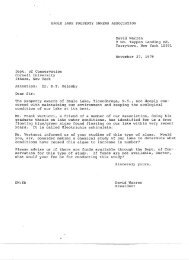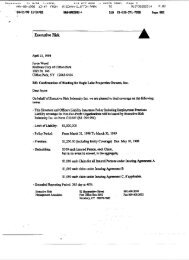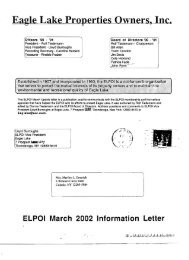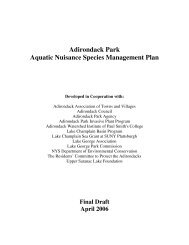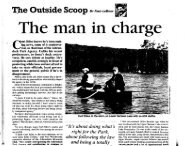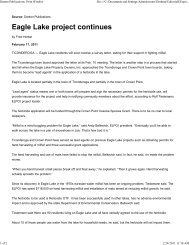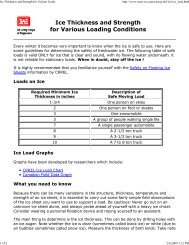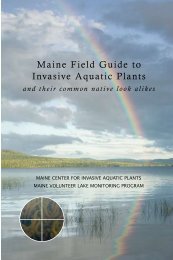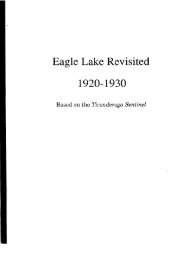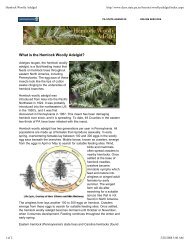SEIS - Eagle Lake Property Owner's Inc.
SEIS - Eagle Lake Property Owner's Inc.
SEIS - Eagle Lake Property Owner's Inc.
Create successful ePaper yourself
Turn your PDF publications into a flip-book with our unique Google optimized e-Paper software.
Cost for suction harvesting in <strong>Lake</strong> George have been on the order of about $9150/acre,substantially higher than the figure of $4,000/acre reported for suction harvesting in NewZealand (Clayton, pers. comm.). Even if the lower rate could be achieved, the cost would beprohibitive on a large scale. Therefore, while suction harvesting is technically possible for largerareas, its practical utility on more than a small scale is clearly limited by cost. Additionally,supplementary and follow-up hand harvesting will been necessary in most cases, based onexperience in <strong>Lake</strong> George.Mechanized CuttingCutting is also exactly what it appears to be. A blade of some kind is applied to plants, severingthe active apical meristem (location of growth) and possibly much more of the plant from theremaining rooted portion. Regrowth is expected, and in some species that regrowth is so rapidthat it negates the benefits of the cutting in only a week or two. If the plant can be cut closeenough to the bottom, or repeatedly, it will sometimes die, but this is more the exception than therule. Cutting is defined here as an operation which does not involve collecting the plants oncethey are cut, so impacts to dissolved oxygen are possible in large scale cutting operations.The most high technology cutting technique involves the use of mechanized barges normallyassociated with harvesting operations, in which plants are normally collected for out-of-Iakedisposal. In its use as a cutting technology, the "harvester" cuts the plants but does not collectthem. A recent modification in this technique employs a grinding apparatus which ensures thatviable plant fragments are minimized after processing. There is a distinct potential for dissolvedoxygen impacts as the plant biomass decays, much like what would be expected from mostherbicide treatments.Harvesting may involve collection in nets or small boats towed by the person collecting theweeds, or can employ smaller boat-mounted cutting tools that haul the cut biomass into the boatfor eventual disposal on land. It can also be accomplished with larger, commercial machines withnumerous blades, a conveyor system, and a substantial storage area for cut plants. Offloadingaccessories are available, allowing easy transfer of weeds from the harvester to trucks that haulthe weeds to a compo sting area. Choice of equipment is really a question of scale with mostlarger harvesting operations employing commercially manufactured machines built tospecifications suited to the job. Some lake associations choose to purchase and operateharvesters, while others prefer to contract harvesting services to a firm that specializes in lakemanagement efforts.Cutting rates for commercial harvesters tend to range from about 0.2 to 0.6 acres per hour,depending on machine size and operator ability, but the range of possible rates is larger. Even atthe highest conceivable rate, harvesting is a slow process that may leave some lake usersdissatisfied with progress in controlling aquatic plants. \Veed disposal is not usually a problem,in part because lakeshore residents and farmers often will use the weeds as mulch and fertilizer.Also, since aquatic plants are more than 90 percent water, their dry bulk is comparatively small.D<strong>SEIS</strong> for <strong>Eagle</strong> <strong>Lake</strong> 38 ENSR



